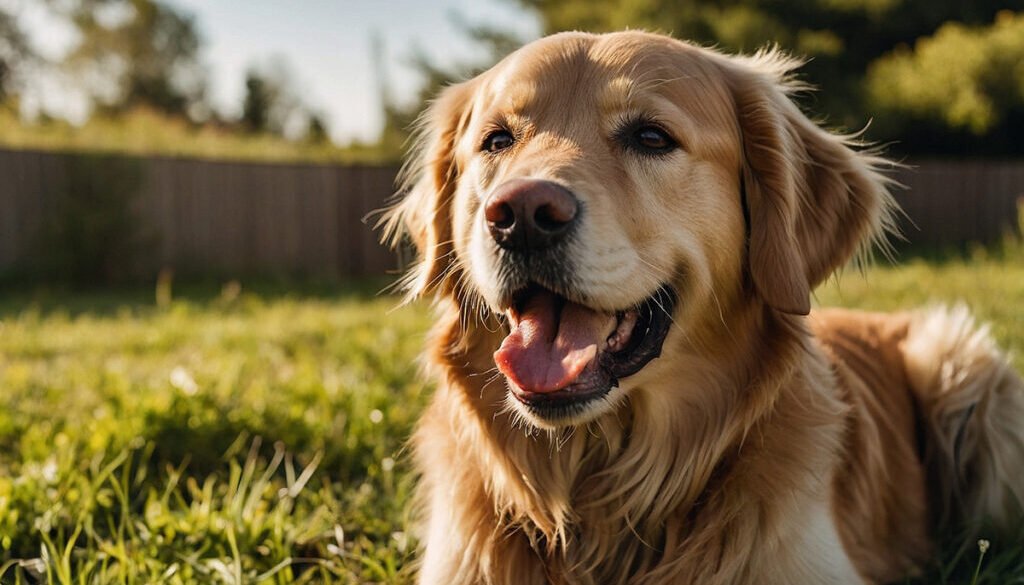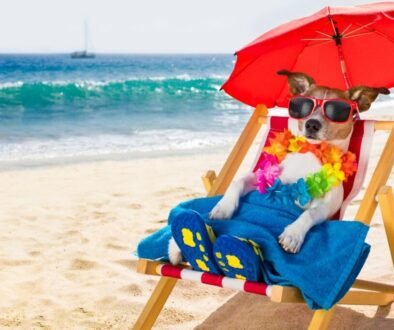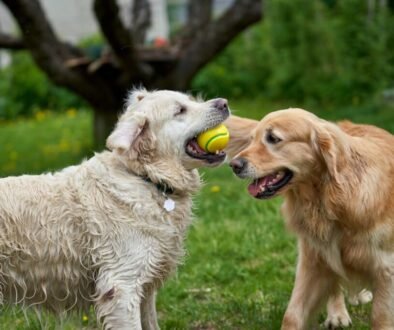Creating the Best Environment for Your Golden Retriever
Are You Giving Your Golden Retriever the Best Life?
Have you ever wondered if your Golden Retriever is truly thriving in their environment? These fluffy, lovable companions are known for their warm smiles, wagging tails, and unmatched loyalty, but many owners underestimate the role that environment plays in their dog’s well-being. Did you know that poor environmental conditions can lead to behavioral problems like anxiety, restlessness, or even aggression in dogs?
Golden Retrievers aren’t just any breed—they’re energetic, affectionate, and need the perfect balance of space, stimulation, and companionship. In this article, we’ll explore what makes an environment ideal for your Golden Retriever and how you can give them the happy, healthy life they deserve. By the end, you’ll not only feel more confident as a dog parent but also know exactly how to set up a home your furry friend will thrive in.
So, are you ready to transform your living space into the ultimate Golden Retriever paradise? Let’s get started!
Understanding Your Golden Retriever’s Needs
Golden Retrievers are a unique breed with specific characteristics and needs that shape the environment they thrive in. Before we jump into actionable steps, let’s take a closer look at what makes this breed so special.
Their Friendly Nature
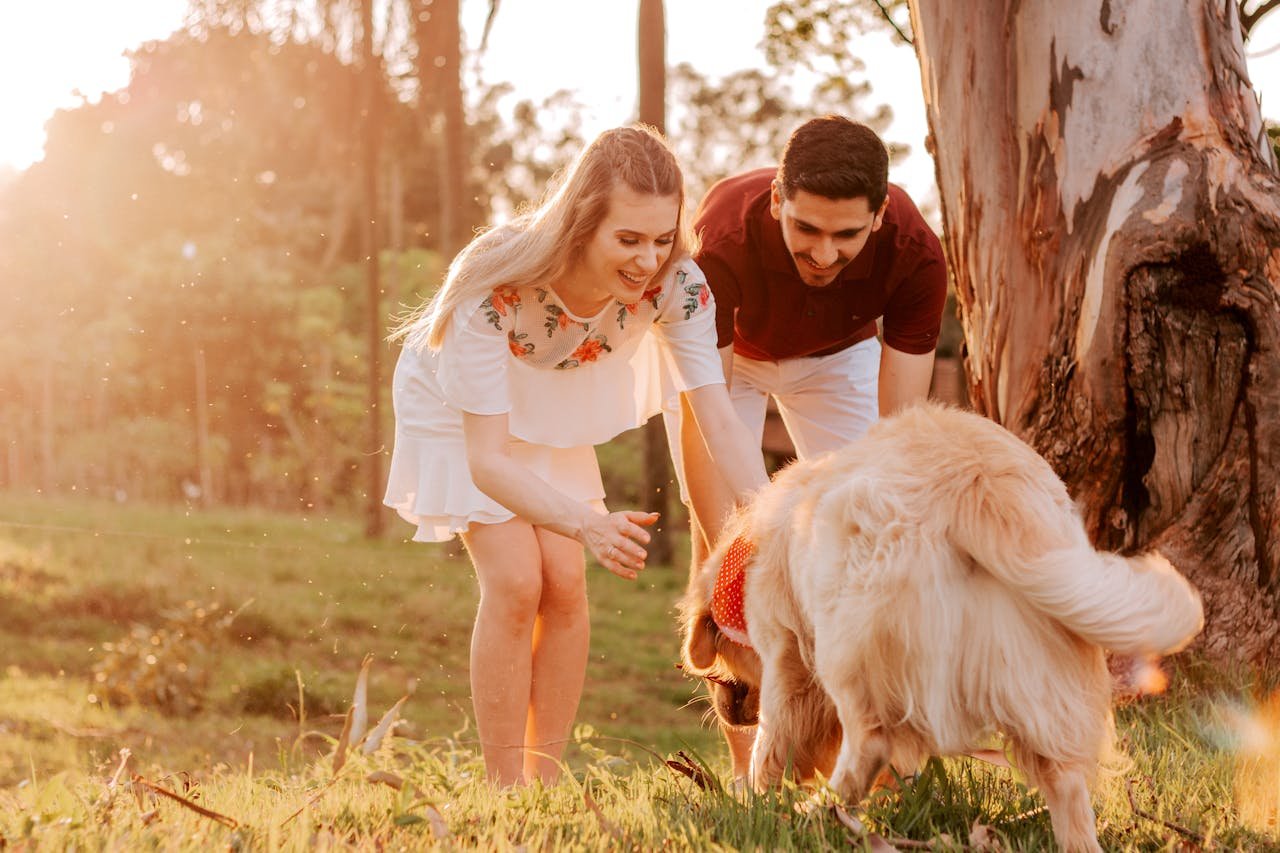
Golden Retrievers are people dogs. They adore being around humans, whether it’s their immediate family or a stranger who just walked through the door. According to the American Kennel Club (AKC), Golden Retrievers are one of the most popular breeds in the United States, ranking consistently in the top three year after year. Why? Their affectionate, friendly personality makes them fantastic family pets.
“A Golden Retriever will never let you feel lonely—they’re like a walking hug with fur!”
Because of their social nature, these dogs need a living environment that fosters interaction. They don’t do well left alone for long periods, which can lead to separation anxiety and destructive behavior.
Meet Lucy and Her Golden, Charlie:
Lucy adopted Charlie, a 2-year-old Golden Retriever, from a rescue shelter. Initially, Charlie was shy around strangers, but after a few months in a loving home, he became the neighborhood’s favorite. “He greets everyone with his wagging tail and even joins the kids for their soccer games,” Lucy shares. “We can’t walk down the street without someone stopping to say hi to Charlie!”
High Energy and Love for Play
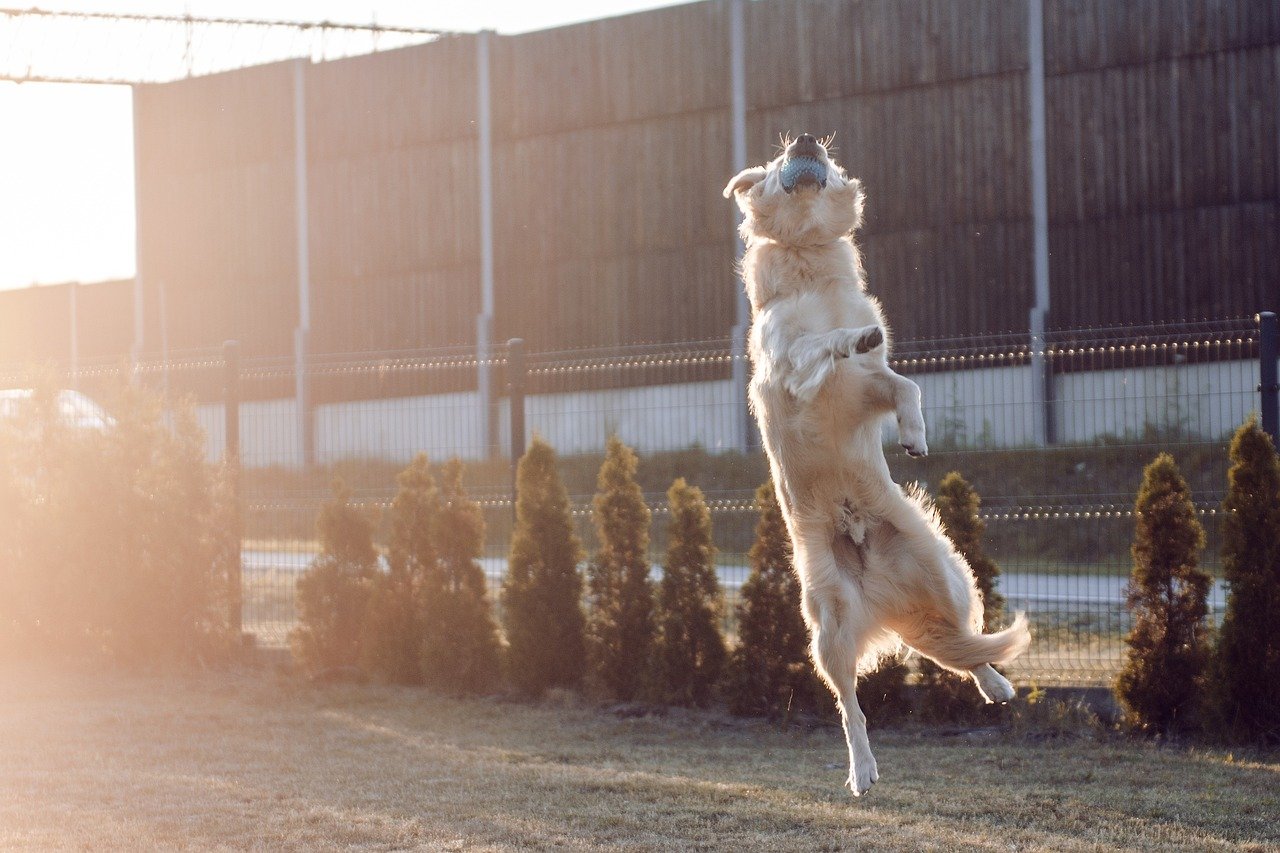
Golden Retrievers are natural athletes. Originally bred as hunting dogs, they have boundless energy and thrive on physical activity. Whether it’s a game of fetch, a swim in the lake, or a hike through the woods, this breed is happiest when active.
However, this energy means that cramped apartments or inactive households can leave them feeling restless. Without proper outlets, they may resort to chewing furniture or other destructive behaviors. This is why their environment must include ample opportunities for play and exercise.
Jack’s Daily Adventure with Max:
Jack, an avid hiker, always wanted a dog that could keep up with his active lifestyle. Enter Max, a Golden Retriever with boundless energy. “We go on 5-mile hikes almost every weekend,” says Jack. “Max loves climbing rocks, splashing in streams, and chasing birds. On rainy days, we play fetch in the living room to keep him entertained.” Max’s enthusiasm is a reminder of how important it is to match your Golden Retriever’s energy level with your lifestyle.
The Ideal Environment for a Golden Retriever
Creating the perfect home for a Golden Retriever involves a mix of physical space, mental stimulation, and emotional care. Let’s break it down.
Space to Roam
Golden Retrievers need room to move. While they can adapt to smaller living spaces, such as apartments, they do best in homes with a yard. A securely fenced yard is ideal for letting your dog run, play, and explore without worry.
- Minimum yard size: About 500-1,000 square feet of open space.
- Urban dwellers: Regular trips to a local dog park can compensate for a lack of yard space.
Even if you don’t have a yard, indoor space matters. Your home should have enough room for your dog to stretch out, play with toys, and move around without constantly bumping into furniture.
Safe and Secure Indoors
When indoors, a Golden Retriever’s environment should be comfortable and safe. Here’s how you can create a secure living space:
- Dog-proof your home: Remove toxic plants, secure electrical cords, and keep small objects out of reach.
- Provide cozy rest areas: A soft bed in a quiet corner is perfect for napping after playtime.
- Temperature control: Golden Retrievers have thick coats, so they’re prone to overheating. Keep your home cool during warmer months.
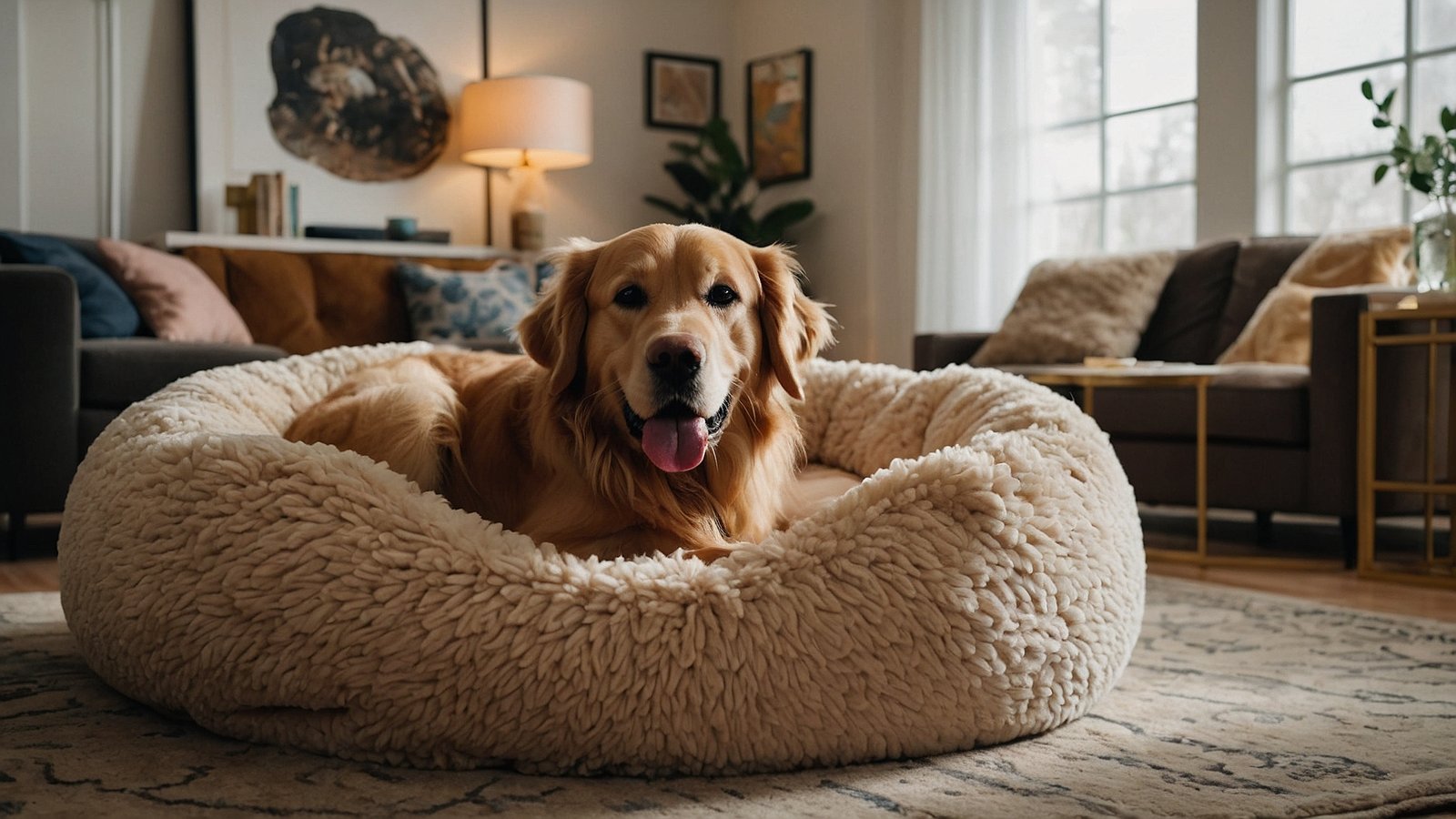
Indoor Essentials for a Happy Pup:
Create a comfortable and secure indoor environment with these essentials:
- Dog Bed: The Bedsure Orthopedic Dog Bed is great for older Golden Retrievers who need extra joint support.
- Baby Gate: Use the Regalo Easy Step Walk-Through Gate to block off unsafe areas in your home.
- Chew Toys: The Nylabone Power Chew Durable Dog Toy satisfies chewing instincts and helps keep your pup occupied indoors.
These products can help create a safe, cozy space for your Golden Retriever to relax.
Exercise Requirements
Golden Retrievers need at least 1-2 hours of exercise daily. Lack of exercise can lead to obesity, which is a common health issue for this breed. Some great ways to keep your Golden Retriever active include:
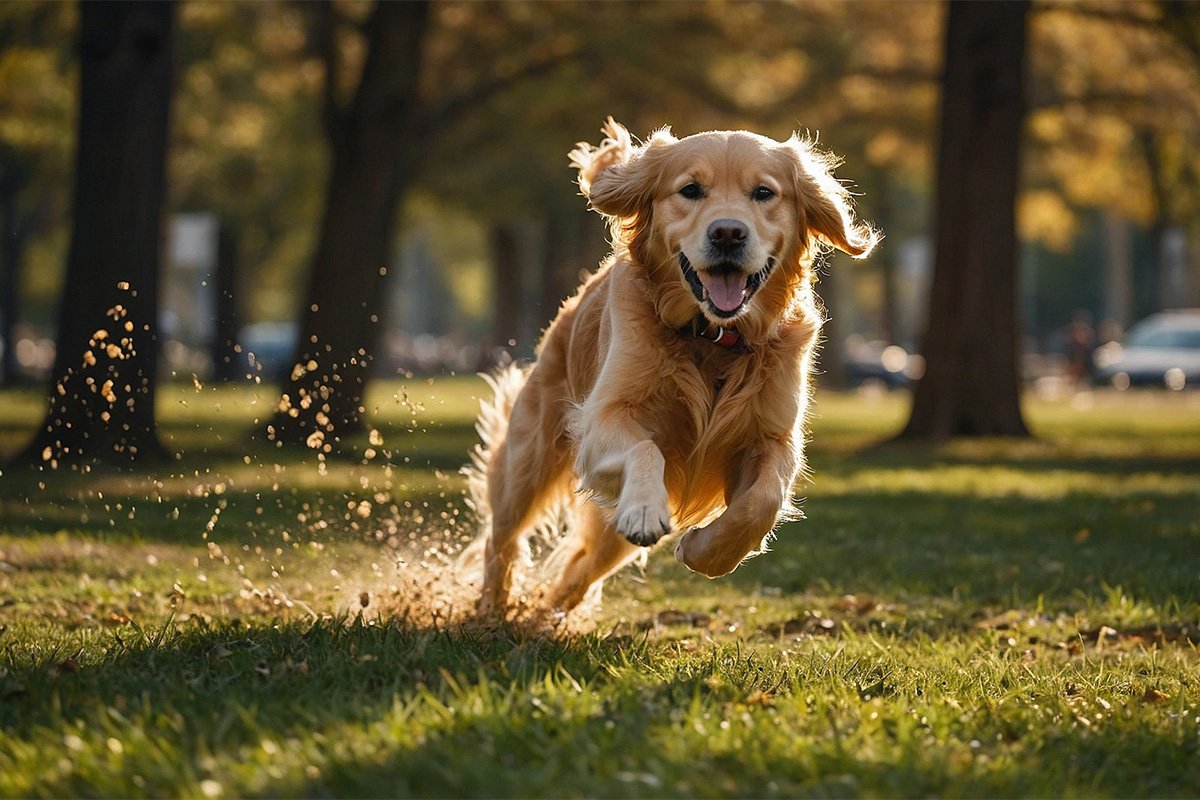
- Walks: Aim for two 30-minute walks per day.
- Fetch: A simple game in the backyard or park can burn off a lot of energy.
- Swimming: Golden Retrievers love water and are natural swimmers.
- Agility courses: These keep them physically and mentally engaged.
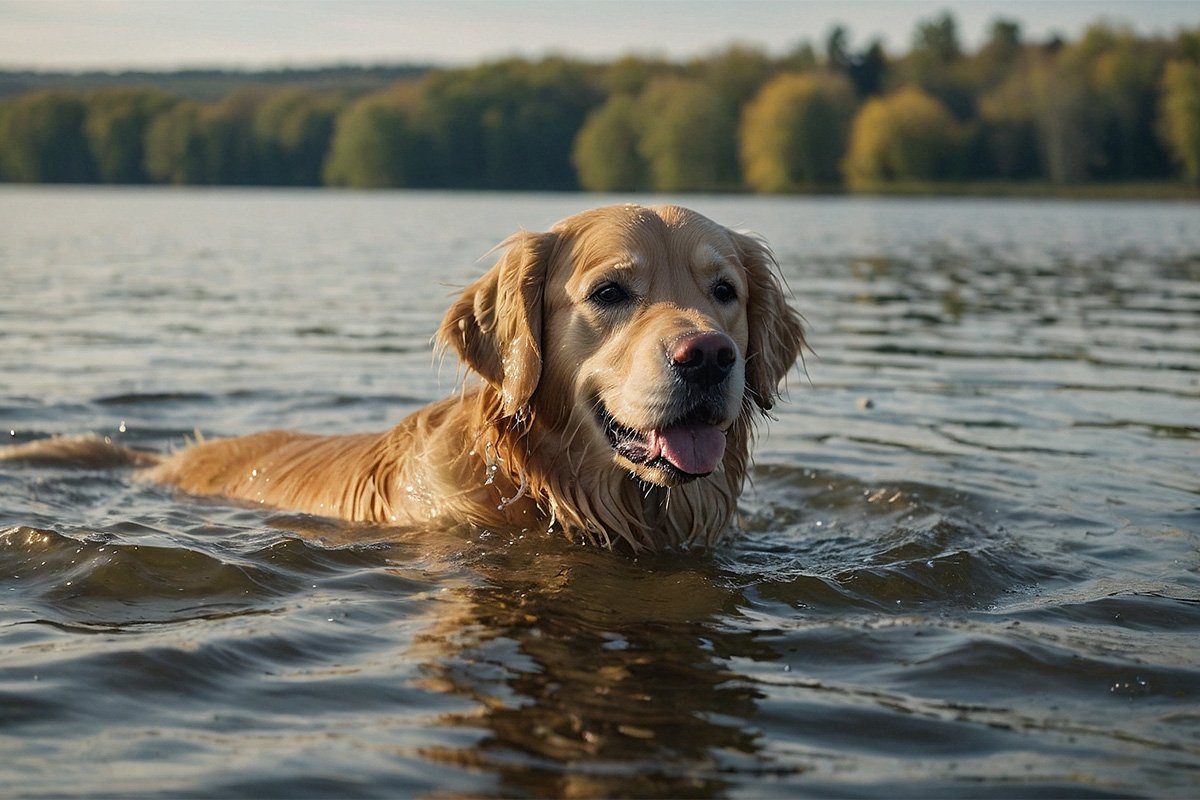
Gear for Active Golden Retrievers:
Ensuring your Golden gets enough exercise is easier with the right equipment:
- Leash and Harness: The Ruffwear Front Range Dog Harness is padded and adjustable, making long walks more comfortable for both you and your dog.
- Fetch Toys: Golden Retrievers love the Chuckit! Ultra Ball, which is durable and bounces high for an exciting game of fetch.
- Portable Water Bottle: Keep your dog hydrated during outdoor adventures with the MalsiPree Dog Water Bottle, which has an easy-to-use design.
Whether it’s a simple walk or a vigorous game of fetch, these tools can make outdoor activities more enjoyable.
Exercise Adjustments for Senior Golden Retrievers:
As Golden Retrievers age, their activity levels and physical capabilities change. While they may not sprint as they used to, regular low-impact activities like short walks or gentle play are essential for maintaining their health.
- Consider investing in joint supplements like Nutramax Cosequin Joint Health Supplement to support mobility.
- For comfort during walks, a lightweight, padded harness like the Kurgo Journey Dog Harness is ideal for older dogs.
Aging doesn’t mean slowing down entirely; it’s about adapting activities to fit their needs.
Case Study: How the Johnson Family Keeps Bella Fit
The Johnson family lives in a suburban home with no backyard, but they’ve found creative ways to ensure their Golden Retriever, Bella, gets her exercise. “We schedule two long walks daily and visit the dog park three times a week,” says Mrs. Johnson. They also invested in a small agility setup for their basement, where Bella enjoys running through tunnels and jumping over hurdles. As a result, Bella stays healthy and happy despite the lack of outdoor space.
The Role of Companionship
Golden Retrievers are incredibly social animals, and companionship plays a vital role in their well-being.
Are Golden Retrievers Good for Families?
Absolutely! Golden Retrievers are known as one of the best family dogs. They’re patient with children, gentle with toddlers, and often form unbreakable bonds with their owners. Families provide the constant interaction these dogs crave, making a bustling household a great fit.
Fun fact: A Golden Retriever’s calm temperament makes them excellent therapy and service dogs!
Golden Retrievers and Other Pets
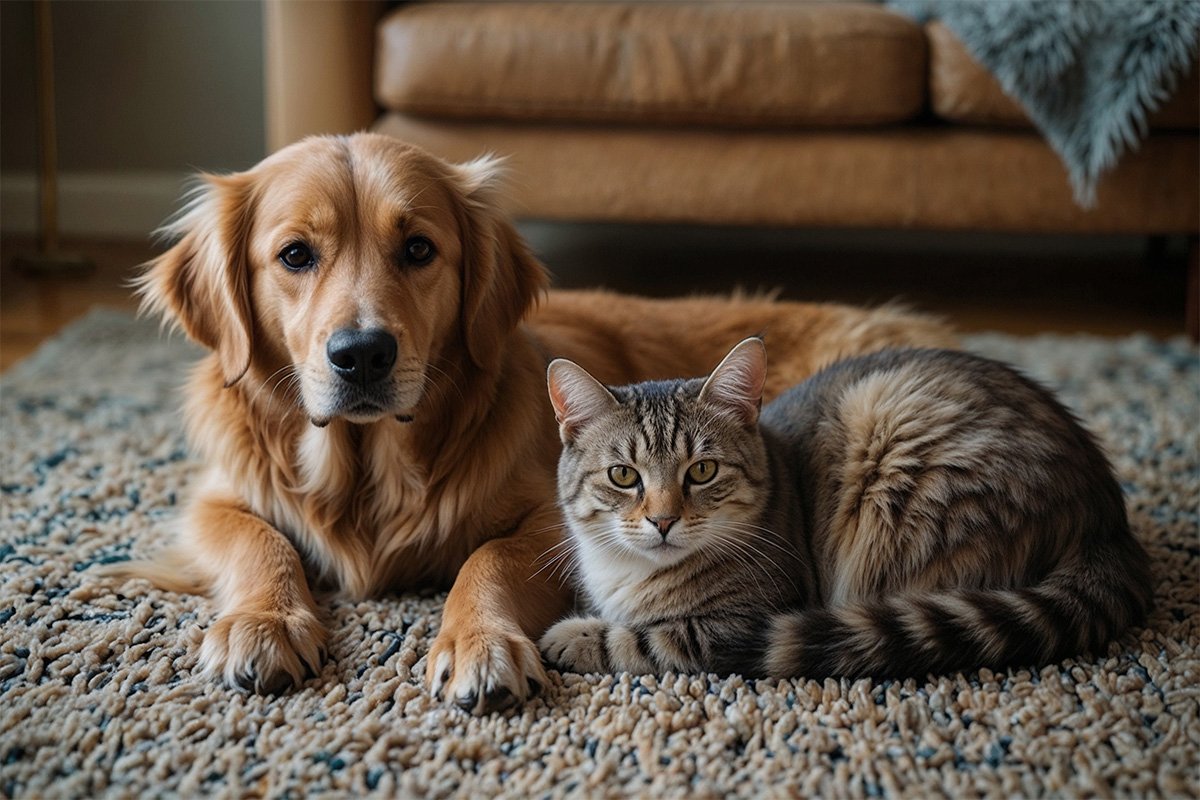
Golden Retrievers are usually friendly with other animals, including cats and other dogs. If you’re introducing a new pet to your household, a slow and controlled introduction process can help ensure harmony.
Pro tip: Monitor interactions at first, especially during meals, to prevent resource guarding.
Maintaining a Healthy Environment
Beyond space and companionship, a Golden Retriever’s environment should support their physical health and mental stimulation.
Nutrition and Hydration
A healthy Golden Retriever starts with proper diet and hydration. Provide high-quality dog food that meets their nutritional needs, and always have fresh water available. Avoid overfeeding, as this breed is prone to weight gain.
- Daily calorie intake: Approximately 1,200–1,600 calories, depending on size and activity level.
- Healthy treats: Carrot sticks, apple slices, or store-bought low-calorie options.
Recommended Dog Food and Treats:
Proper nutrition is essential for your Golden Retriever’s health. Here are some tried-and-true favorites:
- Dry Food: Hill’s Science Diet Large Breed Adult Dog Food is formulated to meet the nutritional needs of active breeds like Golden Retrievers.
- Wet Food: For variety, consider Blue Buffalo Homestyle Recipe Wet Dog Food, which is rich in protein and flavor.
- Healthy Treats: Golden Retrievers love Zuke’s Mini Naturals Training Treats, which are low-calorie and perfect for rewarding good behavior.
Preventing Obesity in Golden Retrievers:
Golden Retrievers love their food, but obesity can lead to joint issues and other health problems.
- Choose weight-management formulas like Purina Pro Plan Weight Management Dog Food to control calorie intake without sacrificing nutrition.
- Use portion-control tools like the Petlibro Automatic Dog Feeder to avoid overfeeding.
Keeping an eye on your Golden’s weight ensures they stay happy and active longer!
Addressing Food Allergies in Golden Retrievers
Golden Retrievers are prone to food allergies, which can cause symptoms like itching, digestive upset, or ear infections. If your pup shows signs of an allergy, consult your vet and consider switching to a limited-ingredient diet like Natural Balance L.I.D. Limited Ingredient Diets. For treats, hypoallergenic options like Hill’s Prescription Diet Hypoallergenic Dog Treats can be a safe choice.
Quick Tip: Keep a food journal to track what your dog eats and identify potential triggers!
Pro Tip: Always consult your vet before making major changes to your dog’s diet!
Grooming Needs
Golden Retrievers are known for their thick, double-layered coats, which require regular maintenance.
- Brushing: Brush their coat 2-3 times a week to reduce shedding and prevent matting.
- Bathing: A bath every 4-6 weeks is usually sufficient unless they’ve had a muddy adventure.
- Dental care: Brush their teeth 2-3 times per week to prevent tartar buildup.
Recommended Grooming Tools:
Keeping your Golden Retriever’s coat looking its best requires the right tools. Here are a few top-rated options:
- Slicker Brush: The Hertzko Self-Cleaning Slicker Brush is perfect for removing loose fur and tangles, making grooming sessions quick and easy.
- De-shedding Tool: For heavy shedding seasons, the FURminator Undercoat De-Shedding Tool can drastically reduce shedding while keeping their coat healthy.
- Dog Shampoo: Try the Earthbath Oatmeal & Aloe Dog Shampoo for a gentle, hypoallergenic bath that soothes sensitive skin.
These tools not only make grooming more effective but also ensure your dog stays comfortable during the process.
Managing Skin Sensitivities and Allergies:
Golden Retrievers are prone to skin conditions like hot spots or allergic reactions. Regular grooming with hypoallergenic products can help keep their skin healthy.
- Opt for a gentle shampoo like Vet’s Best Hypo-Allergenic Dog Shampoo to soothe irritation.
- Use a moisturizing spray like Burt’s Bees for Dogs Natural Itch Soothing Spray for instant relief from itching.
Grooming isn’t just about appearances; it’s a key part of managing their overall health.
Mental Stimulation
Golden Retrievers are intelligent dogs that thrive on mental challenges. Without proper stimulation, they can become bored and mischievous. Some ideas to keep their minds engaged include:
- Interactive toys: Puzzle feeders and treat-dispensing toys work wonders.
- Training sessions: Regular obedience training reinforces good behavior while mentally stimulating your dog.
- Games: Hide-and-seek, scavenger hunts, or even teaching new tricks can keep them sharp.
Interactive Toys to Keep Your Golden Retriever Engaged:
Golden Retrievers are highly intelligent and love a good mental challenge. Here are some popular options:
- Puzzle Feeder: The Outward Hound Nina Ottosson Puzzle Toy provides hours of entertainment and helps prevent boredom.
- Treat-Dispensing Ball: The KONG Classic Dog Toy can be stuffed with peanut butter or treats for a fun, engaging activity.
- Agility Set: If you’re feeling ambitious, the PawHut Dog Agility Training Equipment Set is a fantastic way to give your Golden Retriever both mental and physical exercise.
These toys not only keep your dog entertained but also help reduce destructive behaviors caused by boredom.
Cognitive Challenges in Senior Dogs:
As Golden Retrievers age, they may experience cognitive decline, which can affect their behavior and responsiveness.
- Interactive toys like the Trixie Activity Strategy Game can help keep their minds sharp.
- Supplements such as Zesty Paws Senior Advanced Multivitamin support brain health and overall wellness.
Providing mental stimulation becomes even more critical in their golden years!
Common Environmental Hazards for Golden Retrievers
Golden Retrievers are naturally curious and love to explore, but their curiosity can sometimes lead to trouble. Be aware of these common household and outdoor hazards to keep your pup safe:
- Toxic Plants: Popular houseplants like philodendrons, lilies, or pothos can be harmful if ingested. For outdoor areas, watch for azaleas, sago palms, or daffodils.
- Tip: Replace toxic plants with pet-friendly ones like spider plants or Boston ferns.
- Household Chemicals: Cleaning supplies, antifreeze, and even some essential oils can be highly toxic. Always store these items securely out of your dog’s reach.
- Tip: Switch to pet-safe cleaning products like Puracy All-Purpose Cleaner.
- Human Foods: Common snacks like chocolate, grapes, or onions can cause serious health issues for dogs. Make sure human treats are stored safely away from counter-surfing paws.
- Outdoor Dangers: Be cautious of pesticides, fertilizers, or mulch treated with cocoa, which can be harmful if consumed.
- Tip: Use organic, pet-safe alternatives like Espoma Organic Lawn Fertilizer.
By eliminating these hazards, you create a safe, worry-free environment for your Golden Retriever to thrive in!
Conclusion: A Happy Home for a Happy Golden Retriever
Golden Retrievers bring joy, love, and companionship into our lives, and they deserve nothing less than the best environment we can provide. Whether it’s ensuring they have enough space to play, proper nutrition, or plenty of love and interaction, creating the perfect home for your Golden Retriever is all about balance.
By understanding their needs and making thoughtful adjustments to your living space, you can ensure your Golden Retriever lives their happiest, healthiest life. After all, a well-cared-for Golden is not just a pet—they’re a cherished family member.
FAQs
Q: Can Golden Retrievers live in apartments?
A: Yes, but they require daily exercise and mental stimulation to prevent boredom. Regular visits to dog parks or long walks are essential.
Q: How much exercise does a Golden Retriever need?
A: At least 1-2 hours of physical activity per day, including walks, games, and free play.
Q: Are Golden Retrievers high-maintenance?
A: They require regular grooming and attention but are generally easygoing, making them manageable with a good routine.
Q: Do Golden Retrievers get along with kids?
A: Absolutely! They are one of the most family-friendly breeds and are gentle and patient with children.
Q: How can I keep my Golden Retriever mentally stimulated?
A: Use puzzle toys, teach new tricks, and play interactive games like hide-and-seek.
By following these guidelines, you can ensure your Golden Retriever feels loved, secure, and part of the family. 🐾
